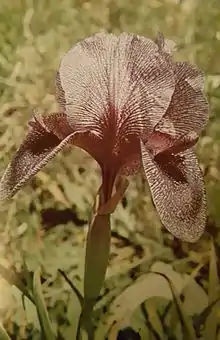Iris susiana
Iris susiana (Mourning Iris) is a species of plant in the family Iridaceae native to Lebanon. This beautiful and big iris, with a span easily reaching twelve centimeters. It grows nowadays in Lebanon, Syria and Turkey where its survival is seriously threatened by excessive picking.[2]
| Iris susiana | |
|---|---|
 | |
| Iris susiana | |
| Scientific classification | |
| Kingdom: | Plantae |
| Clade: | Tracheophytes |
| Clade: | Angiosperms |
| Clade: | Monocots |
| Order: | Asparagales |
| Family: | Iridaceae |
| Genus: | Iris |
| Subgenus: | Iris subg. Iris |
| Section: | Iris sect. Oncocyclus |
| Species: | I. susiana |
| Binomial name | |
| Iris susiana | |
| Synonyms[1] | |
| |
Description
Perennial. Rhizome short and compact. The glaucous,[3] leaves are slightly curved, 25 cm long over 5–12 mm wide, Spathes slightly dilate at base. External tepals reflexed, ovate, 7 cm long over 4 cm wide, strongly spotted with purple on bluish-white background. Ungis covered with numerous hairs, occupying a broad surface, followed by a large purple-violaceous spot. Internal tepals erect, colored as much as external tepals or lighter. Veins white or purplish. Branches of style 2–3 cm long, lobes short, rounded; margin denticulate.
It blooms in May.
Taxonomy
.png.webp)
It has the common name of Mourning Iris.[3] Other common names include, chalcedonian iris,[4][5][6] great-flowered iris, great spotted iris and mourning widow.[7][8]
In classical literature the Persian/Iranian civilization of Elam was also known as 'Susiana' which was a name derived from its capital Susa. [9]
It has been cultivated since 7000 B.C.[4]
It was first found in Persia and then published and described by botanist Carl Linnaeus in his book Species Plantarum on page 38 in 1753.[1][10][11]
It was verified as Iris susiana by United States Department of Agriculture and the Agricultural Research Service on 4 April 2003,[11]
One of the synonyms of the iris, I. sofarana owes its name to the summer resort of Sofar where it was discovered by a Mr Hartmann about one hundred years ago in 1899.
Distribution and habitat
Iris susiana is endemic to Lebanon. It is found on mountains, on eastern slope, in stony and rocky places. It is also found in Turkey and Syria.
Cultivation
Irises can generally be propagated by division.[3][12] It can be grown in sunny nooks within the rock garden, or on sheltered banks or in borders. It needs light warmth and well drained soils. It is thought to be easier to cultivate in south and west UK than in London, although in cold areas, protection during the winter is best.[3]
Toxicity
Like many other irises, most parts of the plant are poisonous (including rhizome and leaves), if mistakenly ingested, it can cause stomach pains and vomiting. Also handling the plant may cause a skin irritation or an allergic reaction. [13]
References
- "Iris susiana L." www.theplantlist.org. Retrieved 12 October 2020.
- Mustapha Nehmeh, Wild Flowers Of Lebanon, National Council For Scientific Research,1978,pages 155,156.
- William Robinson Hardy Flowers, p. 153, at Google Books
- Stebbings, Geoff (1997). The Gardener's Guide to Growing Irises. Newton Abbot: David and Charles. pp. 7. ISBN 0715305395.
- Philip McMillan Browse Heligan: Fruit, Flowers and Herbs (2005), p. 176, at Google Books
- Country Life (magazine) Country Life Illustrated, Volume 9, 1st June 1901, p. 686, at Google Books
- Margery Fish An all the Year Garden (1966), p. 49, at Google Books
- Christopher Brickell RHS Encyclopedia Of Plants and Flowers (5th Ed. 2010), p. 613, at Google Books
- Rev. John Brown A Dictionary of the Holy Bible (1769), p. 621, at Google Books
- "Iris susiana". www.ipni.org. International Plant Names Index. Retrieved 12 October 2020.
- "Iris susiana L. GRIN-Global". npgsweb.ars-grin.gov. Retrieved 12 October 2020.
- "How to divide iris rhizomes". gardenersworld.com. Retrieved 12 October 2015.
- David G Spoerke and Susan C. Smolinske Toxicity of Houseplants , p. 236, at Google Books
Other sources
- Aldén, B., S. Ryman, & M. Hjertson. 2012. Svensk Kulturväxtdatabas, SKUD (Swedish Cultivated and Utility Plants Database; online resource) www.skud.info
- Georges Tohme& Henriette Tohme, Illustrated Flora of Lebanon, National Council For Scientific Research, Second Edition 2014.
- Mathew, B. 1981. The Iris. 59.